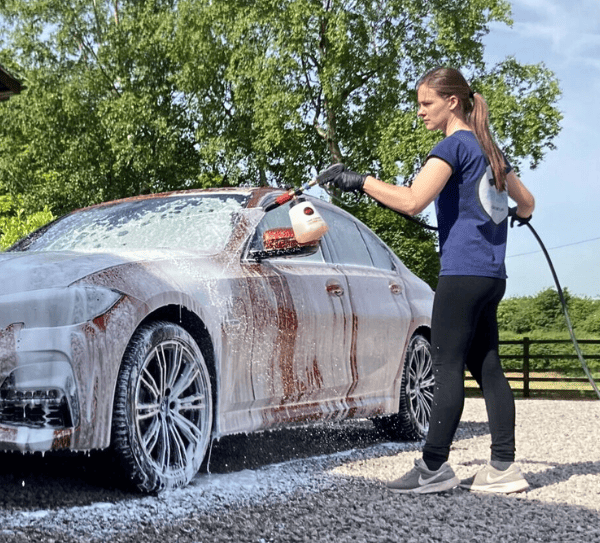Cleaning a car’s engine bay can be a daunting process. A lot of vehicle owners are worried about spraying water over the engine and risking soaking areas that aren’t really designed to get wet. In this article I’ll be talking through my waterless engine bay cleaning routine to make the process less nerve-wracking.
What You’ll Need
- Protective gloves
- All-purpose-cleaner/ citrus degreaser
- Detailing brushes
- Microfiber towels
- Vacuum (optional)
- Car dryer/ compressed air (optional)
- Water-based plastic dressing (optional)

Although I will be pointing out some key considerations to make when cleaning an engine bay, you should always make sure you feel fully comfortable with this task and it’s your responsibility to ensure that you remain safe throughout the process and do not damage the engine.
Step #1 Make Sure the Engine is Cool
This not only stops you from getting burned, but also stops the cleaner from drying out quickly and being ineffective. If you have recently driven the vehicle, you will need to wait until the engine is cool to the touch before starting. Also, make sure you are working in the shade and the ambient temperature isn’t too high.

Step #2 Cover Important Areas
Although I don’t spray water directly onto the engine using this method, I still use an all-purpose-cleaner so there are some areas that you will want to cover if you are concerned about getting them wet. You can cover the following areas with a plastic bag and then tape around the bag so the area is more sealed off:
- Alternator
- Air intake
- Ignition wires
- Exposed coil packs
- Engine control unit (ECU)
- Any other wires/ electrical components
If you plan on cleaning around the battery, you can also disconnect it to prevent getting shocked.
Step #3 Remove any Loose Dirt, Dust or Debris
Often leaves and debris can gather in the panel gaps and rubber seals around the engine bay. If it’s in big clumps, you can just pick it up and dispose of it. However, you may find it useful to use your vacuum to remove any loose debris.
You can also use a car dryer or compressed air to blow dust and sand from more difficult to reach areas. However, you should be careful not to use high pressure to avoid dislodging or displacing any parts in the engine bay.
Using a dry detailing brush can also be useful at this stage to dust any intricate areas if you do not have compressed air.

Step #4 Clean the Underside of the Hood
The first area you should clean is the underside of the hood/ bonnet, to avoid dripping chemical, dirt or grease onto a clean engine bay.
Spray some of your cleaner onto a microfiber towel and wipe the painted areas until clean. You can also spray some of the cleaner onto your detailing brushes to agitate any stubborn grime or intricate areas before wiping clean.
Tip: always spray your cleaner onto the microfiber towel/ brush rather than the surface directly to prevent overspray.
Many cars will have an insulation panel (heat shield) that covers most of the underside of the hood. You should avoid saturating this with any chemicals as it can cause it to sag or loosen. Instead, use a dry microfiber towel to gently wipe it clean.

Step #5 Clean the Rubber Seals and Scuttle Panel
I prefer to work inwards when cleaning an engine bay. This way I’m not leaning over any dirtier areas when trying to access the more central components. Take your detailing brush topped up with some cleaner and gently clean the rubber seals around the engine bay. Then, wipe clean using your microfiber towel.

Step #6 Clean the Engine Bay Components
The next thing I do is actually clean the components of the engine that are not covered using the plastic bags. I take my detailing brush and spray a bit of the cleaner into the bristles (not too much though to avoid it dripping) and use it to agitate each small area at a time. I then use a microfiber towel to wipe the area clean and dry.
You should try and keep your detailing brushes as clean as possible by periodically rinsing them in water and blotting dry. It’s also a good idea to replace your microfiber towel as soon as all the sides are dirty.
Tip: Working in small areas is best as it stops the cleaner/ dirt from drying out and sticking to the surface. This means you don’t need to go over any areas twice.
Take care not to drop your detailing brushes too! If your brushes have a small hole at the end of the handle, you can always tie some string through it so it can wrap around your wrist so if you accidentally let go of the brush it’s less likely to fall into the engine bay.

Step #7 Remove the Plastic Bags
Now your engine is clean you are ready to remove the plastic bags that you placed over some components in the engine bay. If these areas are dirty, use a dry detailing brush or microfiber towel to gently dust these areas.
Step #8 Apply a Dressing to the Plastic Covers
If you’re taking your car to a show and want the engine to look as good as possible, you can use a water-based plastic dressing to darken the appearance of the plastic covers and make them look newer.
Make sure the dressing is water-based rather than solvent-based though (as solvent-based dressing as flammable). You should also check with the manufacturer that the dressing you plan on using is safe for engine bay plastics.
Again, make sure you spray the dressing onto a microfiber towel rather than onto the surface directly to prevent overspray.


